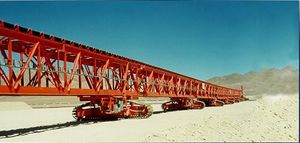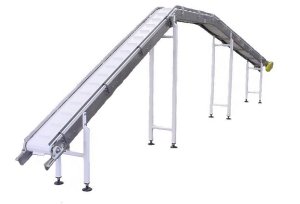Difference between revisions of "Bridge Conveyors"
(Created page with "Category:Conveying{{Knoppen}} <noinclude><!------------------------------------------------ * READ THIS FIRST * Only edit this page if you can improve the content. * Imprope...") |
|||
| Line 7: | Line 7: | ||
* Please start editing this page after the /noinclude | * Please start editing this page after the /noinclude | ||
* -------------------------------------------------></noinclude> | * -------------------------------------------------></noinclude> | ||
[[File:Bridge-conveyors.jpg|thumb|right|Bridge Conveyors]] | |||
[[File:Bridge conveyor1.jpg|thumb|right|Bridge Conveyors]] | |||
'''Bridge Conveyor''' is described as a short conveyor hung from the boom of a mining or loading machine, with the other end attached to a receiving bin that dollies along a frame supported by the room or entry conveyor tailpiece. Thus, as the machine boom moves, the bridge conveyor keeps it in constant connection with the tailpiece. | |||
Bridge conveyor is an automatic unit for the removal of overburden and for dumping it onto the inner spoil banks of opencut mines. The bridge is used with a multibucket excavator. Bridge conveyors are used in working horizontally layered deposits with soft overburden rock in areas where mean annual temperatures are above freezing. | |||
A Bridge conveyor consists of girders resting on two or three supports mounted on rails, or sometimes on crawler tracks. The distance between the supports ranges from 35 to 250 m, and the dumping arm is 40–170 m long. The bridge is set across the pit and moves along the face at 4–6 m/min, taking its rail-and-tie foundation with it. The rock is moved from the excavator to the bridge by connecting conveyors. A bridge conveyor usually has two lines of conveyors 1,000–1,500 mm wide, which move the rock at 7.5–12 m/sec. | |||
Latest revision as of 06:35, 22 August 2012
Bridge Conveyor is described as a short conveyor hung from the boom of a mining or loading machine, with the other end attached to a receiving bin that dollies along a frame supported by the room or entry conveyor tailpiece. Thus, as the machine boom moves, the bridge conveyor keeps it in constant connection with the tailpiece.
Bridge conveyor is an automatic unit for the removal of overburden and for dumping it onto the inner spoil banks of opencut mines. The bridge is used with a multibucket excavator. Bridge conveyors are used in working horizontally layered deposits with soft overburden rock in areas where mean annual temperatures are above freezing.
A Bridge conveyor consists of girders resting on two or three supports mounted on rails, or sometimes on crawler tracks. The distance between the supports ranges from 35 to 250 m, and the dumping arm is 40–170 m long. The bridge is set across the pit and moves along the face at 4–6 m/min, taking its rail-and-tie foundation with it. The rock is moved from the excavator to the bridge by connecting conveyors. A bridge conveyor usually has two lines of conveyors 1,000–1,500 mm wide, which move the rock at 7.5–12 m/sec.

